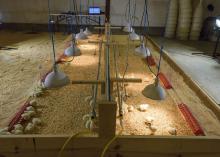Information Possibly Outdated
The information presented on this page was originally released on September 18, 2015. It may not be outdated, but please search our site for more current information. If you plan to quote or reference this information in a publication, please check with the Extension specialist or author before proceeding.
Research measured energy efficiency of poultry heaters
STARKVILLE, Miss. -- When brooding chicks are warm, they grow well in poultry houses, but when heaters are not operating efficiently, it drives up the already high cost of broiler production.
This is the problem John Linhoss, an animal environment specialist with the Mississippi State University Extension Service, took on for his doctoral research. The study was done in cooperation with the U.S. Department of Agriculture-Agriculture Research Service’s Poultry Research Unit in Starkville.
“Radiant heaters are the preferred method of providing heat to chicks during brooding because they are a localized heat source that provides a range of thermal comfort zones to chicks,” Linhoss said. “Although they are used extensively in the broiler industry, very little is known about how efficient they are at providing useful heat to brooding chicks.”
Linhoss said there are about 100,000 commercial poultry houses in the country, and each uses an estimated 4,000 gallons of propane each year.
“If we could improve the efficiency of radiant brooders by 5 percent across the industry, we could save an estimated 20 million gallons of propane a year,” he said. “At roughly $1.50 per gallon, this savings would total roughly $30 million.”
Chicks are brought to broiler houses when they are one day old, but they cannot maintain a constant core internal temperature for the first several days of life. They require external heat sources to keep them warm. Day-old chicks need a temperature of about 92 degrees, but their need for supplemental heat diminishes as they age.
Linhoss set up a system to test the efficiency of six radiant heaters, known as brooders, made by four major manufacturers. The industry recommends brooders be placed 5 feet above the litter of the poultry house, so Linhoss set up tests at 4, 5 and 6 feet above the litter.
He made sensor arrays that recorded 160 radiant flux readings -- or measurements of the density of heat energy -- within the heated area of each brooder. Linhoss suspended these sensors 3 inches above a bed of pine shavings.
“We developed a system that uses radiant flux sensors to measure the heat that reaches the floor,” Linhoss said. “This system is unique in that the sensors directly measure the heat energy in BTUs per square foot.”
Unlike temperature-based data collected in previous studies, this information can be used to quantify the total amount of energy reaching the floor each hour. It can also be used to compare the radiant energy that reaches the floor with the energy in the burning propane. Linhoss said this is the most accurate method currently available to measure the efficiency of radiant heaters.
“We were able to calculate the total energy hitting the floor and determine how efficient each of the heaters are. No one has ever had this information before,” Linhoss said. “There’s been a lot of recommendations made in the past, and we’re trying to put the science behind them regarding the placement of brooders, cleaning of brooders and general operations.”
One of the big discoveries Linhoss made was that radiant heaters are only about 50 percent effective at getting heat to reach the floor where the chicks are. The remaining heat is not lost, but it moves upward to the ceiling and is not directly beneficial to the chicks. This means growers are paying for 100 percent of the cost of the heat but only getting about 50 percent of their money’s worth.
“Because keeping the chicks warm is so energy intensive, if we can reduce the energy consumption, it can have a big impact on the growers’ bottom line,” Linhoss said. “But it’s not just about the bottom line. If we can create a thermal environment that is optimal for the chicks when they are brooding, then overall, we have healthier chickens.”
Chicks that are comfortable eat more consistently and have a better feed-to-growth conversion ratio.
Linhoss’ research will provide the data needed to support industry recommendations on correct brooder placement, maintenance, cleaning and efficiency.
Jody Purswell, a USDA agricultural engineer at the poultry unit, said the idea for the study came from similar work done for heaters used in the swine industry. He said research is needed to keep up with many of the changes the industry has undergone in recent years.
“Modern chicken houses being built this year are very different than those built years ago,” Purswell said. “We’ve started designing bigger buildings with more air flow, but we’re still specifying equipment as we did for small houses.”
He said Linhoss’ data can be scaled easily to apply to any size poultry house, making energy efficiency decisions possible.
“One of the big things we found is that how much heat you actually put into the building for the chicks is a significant mismatch to the rating of the heater,” he said. “What that means for the manufacturers is those heaters are running longer than they should, so we can potentially see some fuel savings if we can make the heaters match the size of the buildings better.”
Purswell said it will also help the chicks themselves, as many do not move as they should when they get cold.
“Chicks regulate their temperature by physically moving,” he said. “Some never get it and hang out in the cold spots. With this data, we can place the heaters to meet the needs of all the chicks.”
Contact: John Linhoss, 662-325-3282







